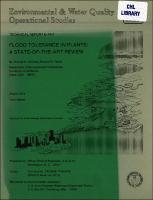Please use this identifier to cite or link to this item:
https://hdl.handle.net/11681/4549| Title: | Flood Tolerance in Plants : a State-of-the-Art Review |
| Authors: | Whitlow, Thomas H. Harris, Richard W. Environmental Laboratory (U.S.) University of California, Davis. Department of Environmental Horticulture |
| Keywords: | Flood tolerance State-of-the-art studies Plants Vegetation Botany Tolerances (Physiology) Reservoirs Absorption of water Mortality |
| Publisher: | Environmental Laboratory (U.S.) U.S. Army Engineer Waterways Experiment Station |
| Series/Report no.: | Technical Report (U.S. Army Engineer Waterways Experiment Station); no. E-79-2 |
| Description: | Technical Report Both the basic aspects of flood tolerance in plants and the applied aspects of establishing vegetation on reservoir shorelines are discussed through a comprehensive literature review. Flooding imposes complex stresses on many vascular plants, most of which arise from the depletion of oxygen in the flooded soil. Soil anoxia results in conditions that favor reduction reactions and anaerobic metabolism, which lead to the formation of ions in reduced valence states and organic acids and gases in concentrations exceeding those in aerobic soils. Changes in pH accompanying soil reduction may also alter nutrient availability. Plants avoid or mitigate those flooding stresses by either transferring oxygen into their roots via anatomical modifications in the shoot and/or by utilizing anaerobic respiration pathways in their roots. In addition to a plant's ability to withstand soil anaerobiosis, plant age, plant size, flood depth, flood duration, flood timing, substrate composition, wave action, and other factors determine survivorship when plants are flooded. Studies are reviewed that correlate these factors with species tolerances. A detailed summary of research relating directly to reservoir revegetation is provided, and species tolerances are assessed for each of the Army Corps of Engineers Divisions. Techniques for the establishment of vegetation around reservoirs are discussed, as are examples of species mortality prediction and impact assessment. Additional work is required concerning the integrated plant response to flooding, refined species tolerance assessments, reservoir revegetation techniques, and the selection of species suitable for reservoir environments. |
| Gov't Doc #: | Technical Report E-79-2 |
| Rights: | Approved for public release; distribution is unlimited. |
| URI: | http://hdl.handle.net/11681/4549 |
| Appears in Collections: | Technical Report |
Files in This Item:
| File | Description | Size | Format | |
|---|---|---|---|---|
| Technical Report E-79-2.pdf | 10.28 MB | Adobe PDF |  View/Open |